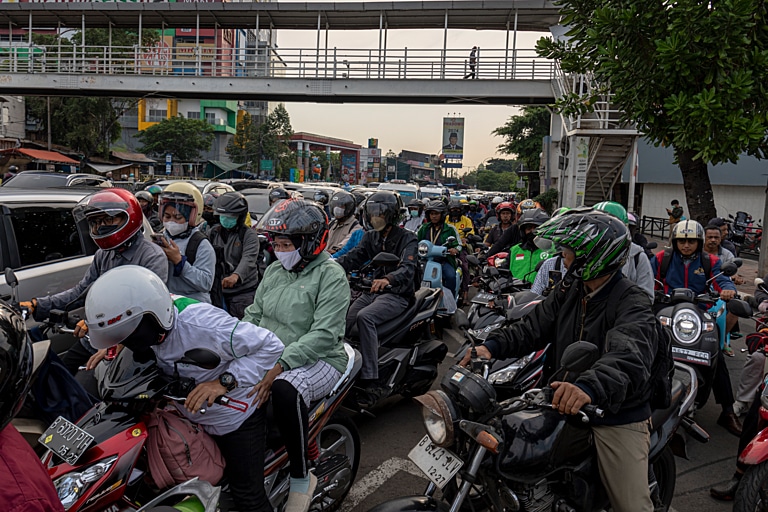Bangladesh was the most polluted country in the world in 2023, with air pollutant levels more than 15 times higher than the safe annual level recommended.
—
Only seven countries in the world – less than 4% – had air quality levels at or below the healthy annual average recommended by the World Health Organization (WHO) in 2023, a new report has found.
Exceptions made for Australia, Estonia, Finland, Grenada, Iceland, Mauritius, and New Zealand, all countries exceeded the annual level last year, Swiss air quality organization IQAir said in its annual report published on Wednesday, with several regions recording highly dangerous pollution levels.
These include Bangladesh, historically among the most polluted countries in the world and the worst in 2023, with PM2.5 levels more than 15 times higher than WHO standards, Pakistan (more than 14 times higher), and India (more than 10 times higher). Tajikistan and Burkina Faso followed closely.
The WHO issued new, more stringent guidelines on air pollution in September 2021, following new research showing fine particulate matter (PM2.5) to be more harmful than previously thought. It set the 24-hour PM2.5 safe limit at 15 μg/m3 and the annual threshold at 5 μg/m3.
| Pollutant | 2021 AQGs |
| Fine particulate matter, µg/m3 | Annual: 5 24-hour: 15 |
| Ozone, µg/m3 | 8-hour: 100 |
| Nitrogen dioxide, µg/m3 | Annual: 25 24-hour: 40 |
PM2.5, the most commonly used unit in air quality measurements, refers to an atmospheric particulate matter that has a diameter of less than 2.5 micrometers (or about 3% the diameter of a human hair) and is said to pose the greatest risk to human health, with studies linking it to premature mortality, heart or lung diseases, acute and chronic bronchitis, asthma attacks, and other respiratory symptoms.
While parts of the world have made substantial progress in terms of air quality in the past century, such as China, which reported a 15% decrease in PM2.5 pollution from 2022, the report’s overall conclusions are still grim.
“Unfortunately things have gone backwards,” said Glory Dolphin Hammes, North America chief executive of IQAir. “The science is pretty clear about the impacts of air pollution and yet we are so accustomed to having a background level of pollution that’s too high to be healthy. We are not making adjustments fast enough.”
Wednesday’s report reaffirms previous WHO data indicating that air pollution levels exceed safe values almost everywhere in the world, with at least 9 out of 10 people worldwide living in places with low air quality. Globally, fine particulate matter (PM2.5) is associated with approximately 7 million deaths around the world every year and causes the average person to lose approximately 2.3 years of life expectancy – or a combined 17.8 billion years.
Contrary to the 20th century, the worst air quality in the world is found in the Global South, especially in developing countries in Africa, South America, and Southeast Asia. There are many reasons that explain this discrepancy.
First and foremost, developing nations are rich in fossil fuels, and coal power plants remain prevalent in these regions. They also heavily rely on solid fuels that are responsible for severe indoor air pollution, such as wood, crop wastes, charcoal, and coal as well as kerosene for cooking, heating, and lighting. Furthermore, they lack technologies and economic resources to fight air pollution and its effects, such as adequate health systems to cure diseases related to this phenomenon. Developing countries also tend to have weak laws and policies, such as less stringent vehicle emission standards, compared to developed nations.

A study last year found that people living in four South Asian nations – Bangladesh, India, Nepal, and Pakistan – are expected to lose about five years of their lives on average because of air pollution. The analysis, conducted by the University of Chicago’s Energy Policy Institute (EPIC), found that particulate pollution in South Asia has increased by 9.7% from 2013 to 2021, contributing to an additional 6 months’ reduction in life expectancy for the region’s residents. According to IQAir, Central and South Asia was home to the most polluted regions and top ten most polluted cities in the world in 2023, with India’s Begusarai ranked as the most polluted metropolitan area.
The EPIC study also found that people living in Sub-Saharan Africa and South Asia regions are significantly more likely to die from outdoor air pollution, with death rates approximately 100 times greater than in Europe and North America.
You might also like: Air Pollution: Have We Reached the Point of No Return?
The link between climate change and air pollution is undeniable. Among the main sources of pollutants in the air are wildfires, a natural phenomenon that is becoming more frequent and intense with global warming, explained Christie Chester Shroeder, a physical scientist and manager of air quality science at IQAir, during a press conference for the release of the report.
Several parts of the world experienced unusually long and intense fire seasons last year. Canada, for example, was affected by a record-setting series of wildfires which burned the largest area in the country’s recorded history, 184,961 square kilometres (45.7 million acres), about 5% of Canada’s entire forest area and more than six times the long-term average for that time of the year.
This made Canada the most polluted country in Northern America last year, with the region’s 13 most polluted cities located within its borders, according to IQAir. On multiple occasions during the fire season, Canadians were put under air quality warnings as toxic smoke covered huge areas in an unhealthy haze. In June 2023, smoke reached parts of the US East Coast, blanketing New York and neighbouring states as far south as Mexico in a thick, orange haze and prompting pollution warnings that affected millions of Americans.
Featured image: Raunaq Chopra/Climate Visuals Countdown


















